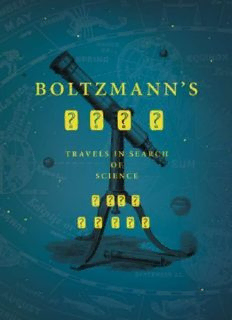
Boltzmann's Tomb: Travels in Search of Science PDF
Preview Boltzmann's Tomb: Travels in Search of Science
Table of Contents ALSO BY BILL GREEN Title Page McMurdo Station and the Dry Valleys West Lafayette and Duino Blacksburg and Dallas Los Angeles and Prague Florence London and Jupiter Bern and Washington, D.C. Pittsburgh and Paris Juneau Titusville and Tucson Vienna Cambridge Munich Oxford, Ohio Afterword Acknowledgments Index Copyright Page ALSO BY BILL GREEN Water, Ice and Stone Improbable Eden: The Dry Valleys of Antarctica A man’s work is nothing but the slow trek to rediscover through the detours of art those two or three great and simple images in whose presence his heart first opened. —Albert Camus Randomness rules our lives. —Leonard Mlodinow McMurdo Station and the Dry Valleys It was my ninth trip to McMurdo Station, the largest United States base in Antarctica. The base crowded down to the edge of the Ross Sea, and from shore you could see the white mountains of Victoria Land rising like a vision of heaven. I liked the small group I had chosen forthis trip and thought we would be perfect for the two lakes we had come to study. Joe was an older chemist, a little overweight, perhaps, and not in the best of health. Through several weeks, I had had to argue with the National Science Foundation that he would be able to do the field studies I had mapped out for him. I had never seen anyone so enthusiastic about an expedition as Joe. At Los Angeles Airport, wearing a cap that counted down the minutes and seconds until the new millennium began, I think he told everyone at the bar and on line for the long flight to Auckland that he was going to Antarctica. If his listener showed even a hint of interest, he would try to explain our entire project. The closer we got to takeoff, the more a smile of expectation lit his face. My student, Joseph, was not nearly as expressive, but he had worked with me for several years in the lab and was immersed in the research. He was fastidious and had a cheerful alliance with small motors, batteries, copper wires, and instruments of all kinds that would make him invaluable in the unpredictable conditions of the Dry Valleys. Experience had taught me that nothing ever went according to plan—pumps and generators broke down, drill bits snapped and the one thing you had not thought to bring in duplicate fell into the deep waters of the lake and would never be seen again. But one thing above all else was true: you could always count on Joseph’s ingenuity and his data. Katy, my daughter, who had wanted to go on one of these journeys since she was barely old enough to miss my long absences, was the fourth member of our group. On college breaks, she had lived in huts along the shore of Brazil’s Salvador, had contracted malaria in the streets of Accra, and had taken on the winter snows of Colorado and Wyoming in her small mountain tent. She was a student in my geochemistry course and so had a broad overview of that science. I had no doubt she, at twenty-one, was ready for this. I did, however, have a few questions about myself. Two years earlier, I had had bypass surgery following a heart attack. The surgeon, who was tall and confident, a former navy commander, said, “We’ll have you in better shape than you’ve been in twenty years.” I wanted to believe it was true; today, I felt strong and ready for our journey south. The world in its vastness and beauty seemed open to me once again. The physical work seemed almost routine by now: dragging the sleds over the rough, wind-blasted ice on Lake Hoare; setting up the peristaltic pump and the Tygon tube so we could collect samples every few centimeters down through the water column; measuring the dissolved oxygen, the conductivity, and the pH. At Lake Fryxell, the hole over the deepest water had already been drilled by another research team so the big rig with its black, screwlike blades and the fifteen feet of extensions that we usually needed for the thick permanent ice was not necessary. Over the years, the work had become easier. There were several groups in the Taylor Valley now, and there were a few semipermanent structures that had been set up for lab work and for cooking hot meals. As I looked out over the valley from the glistening lake ice, I remembered the emptiness of earlier days, when I could imagine there had never been anyone else here, that we were the first explorers, and the land had welcomed us in its silence and majesty, its bare stone mountains rising into cloud. There was, however, a kind of scientific satisfaction in seeing the growing interest in the lakes, that they were no longer the mere biological and
Description: